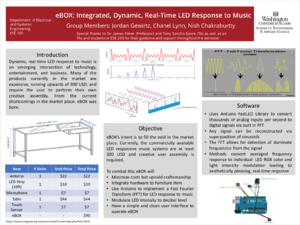EBOX
Project Proposal
Overview
We created an audio responsive LED lighting system integrated on a desk that can be used as a fun addition to one's home entertainment and lighting systems. The EBOX has 3 modes that the user can set with a tap of a touch sensor to customize the dynamic light patterns to fit any mood.
Group Members
Jordan Gewirtz
Chanel Lynn
Nish Chakraburtty
Tony Sancho-Spore (TA)
Dr. James Feher (Prof)
Link to Log
- https://classes.engineering.wustl.edu/ese205/core/index.php?title=EBOX_Log
- eBOX WUSTL BOX: https://wustl.app.box.com/folder/57307264614
Objectives
- Use an Arduino to implement a Fast Fourier Transform(FFT)
- Integrate the FFT through the Arduino with our LED lights
- Make the LED lights respond music with a specific, non-random color scheme
- Have the Light intensity change with the decibel level of the music
- User interface
Challenges
- learn Arduino
- Soldering
- learn complex circuitry
- carpentry
- writing the code and interfacing the Arduino with the LEDs and Sound receptor
- Learn to not short our entire project
- Learn how to use transistors
- Make sure nothing blows up
- Staying under budget
Gantt Chart
Budget
| Item | # of Units: Estimated | # of Units: Actual | Unit Price: Estimated | Unit Price: Actual | Total Price Estimated | Total Price: Actual (Including Shipping) |
| Arduino (Link) | 1 | 1 | $22.00 | $0.00 (Provided by TA) | $22.00 | $0.00 |
| Transistors (Link) | 10 | $0.06 | $0.60 | $0.00 (Provided by TA) | ||
| LED (strips - 6ft) (Link) | 1 | 1 | $21.99 | $21.99 | ||
| Arduino Microphone (Link) | 10 | 10 | $0.88 | $0.69 | $8.88 | $6.90 |
| Table (Link) | 1 | 1 | $39.99 | $39.99 | $39.99 | $43.86 |
| Capacitive Touch Sensors (Link) | - | 5 | - | $1.40 | - | $6.99 |
| Total | 14 | $48.78 |
Design And Solutions
Steps to Build the EBOX
1. Program the color patterns
2. Upload the code to the Arduino
3. Plug leads into the hardware
4. Solder external power source to lights and Arduino
5. CAD box to hold the hardware
6. Assemble table
7. Secure lights around the underside of the table
8. Plug in power source adapter to an outlet, place a speaker near the microphone, and enjoy!
Components
LED Light Strip (6ft)
Arduino Uno
Capacitive touch sensor
Sound Detection Sensor Module (Microphone)
Desk with glass or translucent top
9V adapter
Leads (wires)
The Software
The method of approach in terms of software was to program the Arduino to do a running average of the frequencies coming in from the Fast Fourier Transform and send a message to the LED strip to output a certain pattern of lights.
Music or other forms of audio are inputted to the system through the Arduino microphone. We downloaded a Fast Fourier Transform Library from an open source to translate the analog sound signals into digital signals. A Fourier Transform is a transformation of a function of time into the frequencies that make it up
The Electronics
The Housing
Results
Shortcomings
Poster
External Links
Project Proposal Presentation Powerpoint Link
References
- https://sites.wustl.edu/ese498vertigodancefloor/ (Move to the Groove Reference)
Software References
- https://github.com/kosme/arduinoFFT (Arduino FFT library)
- https:/ing /forum.arduino.cc/index.php?topic=427386.0 (Arduino FFT discussion page)
- https://www.norwegiancreations.com/2017/08/what-is-fft-and-how-can-you-implement-it-on-an-arduino/ (Arduino FFT tutorial)
- https://playground.arduino.cc/Code/Filters (Real Time Digital Signal Processing Library)
- https://www.instructables.com/id/Arduino-Audio-Input/ (Tutorial to take in audio for FFT ~40KHz)
- https://www.instructables.com/id/Arduino-Frequency-Detection/ (Tutorial to analyze in audio for FFT ~40KHz)
- https://www.instructables.com/id/Arduino-Audio-Output/ (Tutorial to output audio for FFT ~40KHz)
- https://www.youtube.com/watch?v=NQinj-tlU-M (LED coding walkthrough)
- https://www.arduino.cc/reference/en/ (Arduino Language Reference)
- https://www.youtube.com/watch?v=5oRir4dck_w (ARDUINO LED LIGHTS WORK AND ARE SOUND RECEPTIVE (with opensource code))
- http://genericnerd.blogspot.com/2009/05/arduino-mood-light-controller.html (Tutorial, LED color transitions)
- https://www.instructables.com/id/Sound-Reactive-LED-strip/ (Simple version of our project)
- https://www.youtube.com/watch?v=e1FVSpkw6q4 (Simple tutorial, make LEDs dance)
Electrical Design References
- https://www.amazon.com/DAOKI-Sensitivity-Microphone-Detection-Arduino/dp/B00XT0PH10 (purchased microphone)
- https://randomnerdtutorials.com/guide-for-microphone-sound-sensor-with-arduino/ (Guide for microphone sound sensor)
- https://www.allaboutcircuits.com/technical-articles/introduction-to-capacitive-touch-sensing/ (Understanding Capacitive Touch Sensors (Self-Capacitance Configuration))
- http://henrysbench.capnfatz.com/henrys-bench/arduino-sensors-and-input/catalex-ttp223b-arduino-capacitive-touch-sensor-tutorial/ (Tutorial Capacitive Touch Sensor Arduino)
- https://www.instructables.com/id/Wire-a-Potentiometer-as-a-Variable-Resistor/ (Potentiometer, Variable Resistor)
- https://www.instructables.com/id/How-to-use-OLED-display-arduino-module/ (Tutorial LED display)
- https://www.instructables.com/id/Sound-Reactive-LED-strip/ (Simple version of our project)
- https://www.youtube.com/watch?v=e1FVSpkw6q4 (Simple tutorial, make LEDs dance)
Physical Design References
- https://www.youtube.com/watch?v=kj-oZgmRB2w&t=73s (OnShape Tutorial)
- https://www.youtube.com/watch?v=pMWnsHpDlQE&t=18s (OnShape Tutorial)
- https://www.youtube.com/watch?v=OasbgnLOuPI (HOW TO BUILD THE TABLE AND INTEGRATE THE LEDS)
eBOX Log https://classes.engineering.wustl.edu/ese205/core/index.php?title=EBOX_Log


